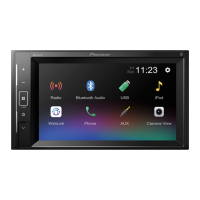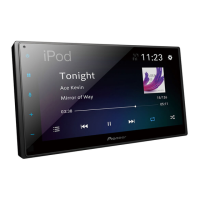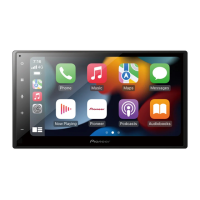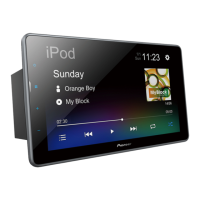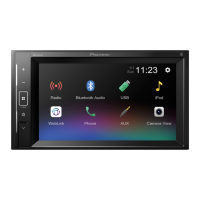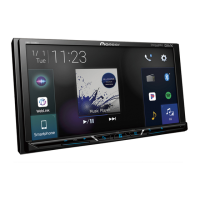Do you have a question about the Pioneer DMH-A340DAB and is the answer not in the manual?
Provides critical safety warnings and precautions for product installation, operation, and potential hazards like electric shock and burns.
Details warnings and requirements for safe driving, including handbrake interlock system and video viewing restrictions.
Instructs users to contact a dealer or service station if the product fails to operate properly.
Illustrates the main unit components for different models (DMH, AVH) with numbered parts.
Details the procedure for resetting the unit to factory settings, including cautions and conditions for reset.
Guides through the process of connecting a mobile device via Bluetooth, including pairing and disconnection.
Explains how to use the hands-free phoning feature, requiring prior Bluetooth connection.
Details the steps for making a phone call using the phone menu and call icons.
Explains how to answer and end a phone call.
Explains how to use the Bluetooth audio player, including basic operations like playback and pause.
Lists the various audio and video sources that can be played or used with the product.
Provides information on aerial requirements and notes for optimal digital radio reception.
Provides instructions for inserting and ejecting various types of discs, with a caution.
Details how to insert and eject media for compressed files, with cautions.
Provides instructions for connecting USB storage devices to different models, with a caution about USB cables.
Guides on connecting an iPhone via USB, mentioning automatic configuration and compatibility details.
Explains how to operate WebLink compatible applications, including necessary app installation and important notes.
Details the steps for connecting an iPhone or Android smartphone to use WebLink.
Explains the automatic switching to the rear view camera when in reverse and the 'Camera View' mode.
Details various system settings like language, iPhone connection boot, safe mode, date/time, camera settings, and dimmer trigger.
Covers audio adjustments including graphic equalizer, fader/balance, volume, loudness, bass boost, and beep tone.
Provides instructions for updating the product's software via a USB storage device.
Lists common problems, their causes, and solutions for operating the product.
Explains how to interpret and resolve various error messages displayed by the product.
Provides essential precautions for handling discs and maintaining the built-in drive to prevent damage.
States WebLink is a trademark and Android is a Google trademark.
Offers advice on data backup, temperature exposure, securing the iPhone, and referring to iPhone manuals.
Lists all iPhone models compatible with the product.
Outlines requirements for app-based services, including app versions, accounts, data plans, and internet connection.
Provides guidelines for using the LCD screen, including avoiding sunlight, temperature ranges, and gentle touch.
Lists general specifications like power source, current consumption, dimensions, and weight for different models.
| DIN size | 2 DIN |
|---|---|
| Output power | 200 W |
| Product color | Black |
| Ready for iPod | Yes |
| Disc types supported | No |
| Audio output channels | 4.0 channels |
| Equalizer bands quantity | 13 |
| Maximum power per channel | 50 W |
| Mobile operating systems supported | Android, iOS |
| Audio formats supported | AAC, FLAC, MP3, WAV, WMA |
| Image formats supported | BMP, JPEG |
| Video formats supported | DIVX, FLV, H.264, MKV, MOV, MPEG2, MPEG4, TS, WMV, XVID |
| Display diagonal | 6.8 \ |
| Touchscreen type | Capacitive |
| Illumination color | Multi |
| Bluetooth profiles | A2DP, HFP, SPP |
| USB ports quantity | 1 |
| DAB tuner | DAB+ |
| Supported radio bands | DAB+, FM |
| Hands-free calling | Keep your hands on wheel with Bluetooth™ Hands-free calling. After pairing your compatible Bluetooth mobile phone to your TomTom GPS, you’ll be able to see incoming call information, make and answer calls, and talk hands-free through your device. You’ll e |
| Built-in processor | - |
| Cables included | USB |

